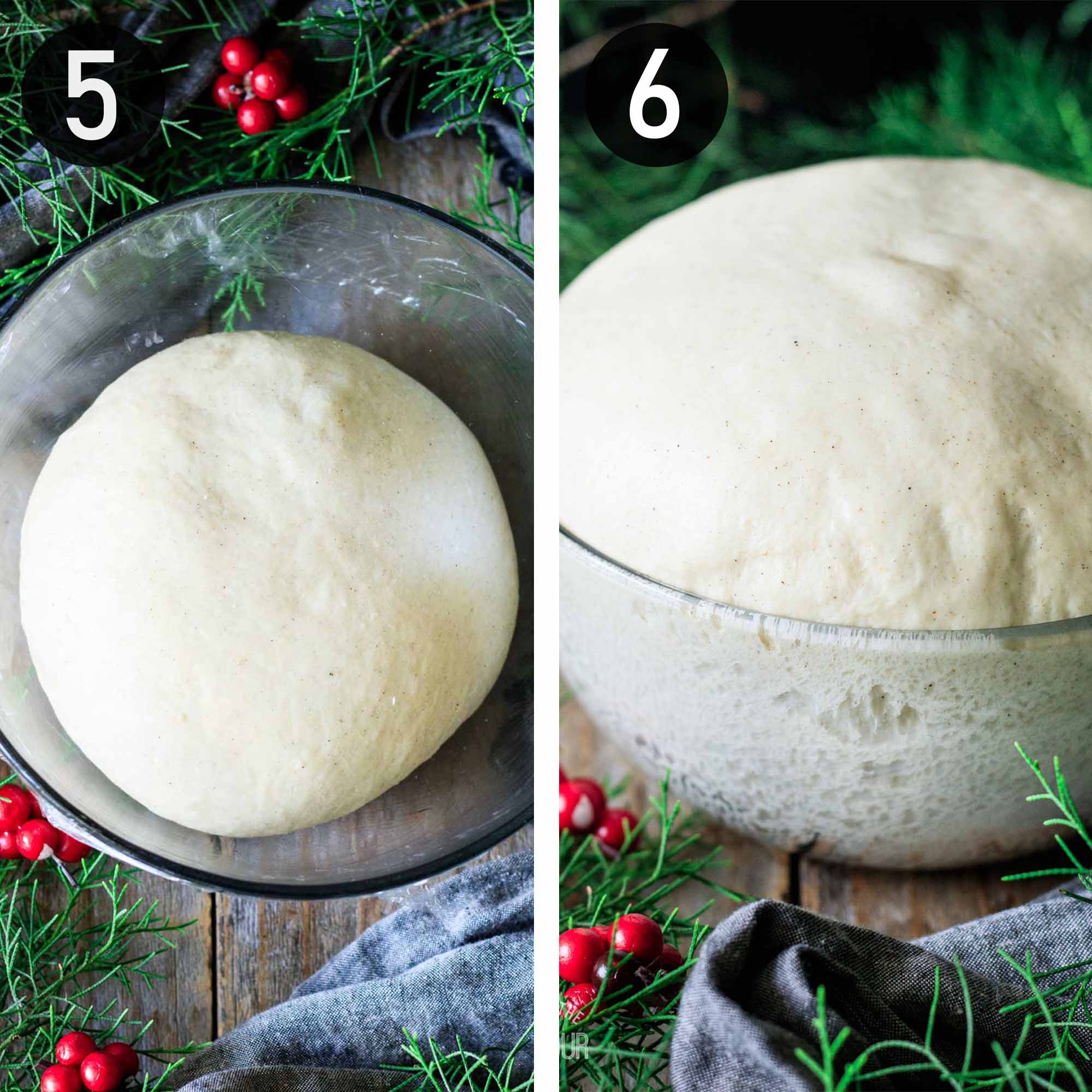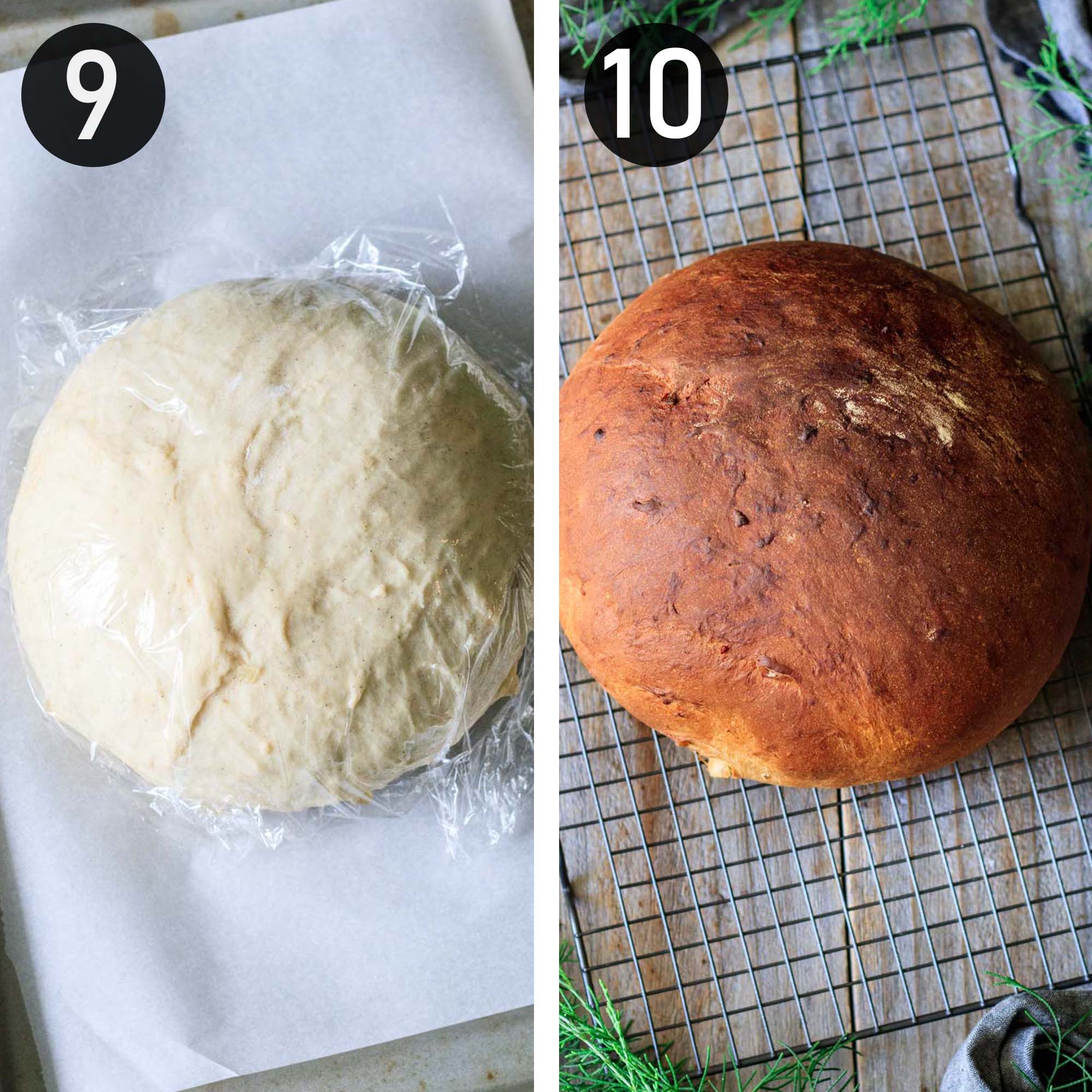Scandinavian breads are always a joy to make, and this julekake (Norwegian Christmas bread) is no exception! Julekake is a delightful Christmas bread that has a touch of sweetness from the dried fruit. You'll enjoy each bite of this festive treat!
If you love Christmas breads, you'll also want to try kanellängd and this Swedish tea ring.
Ingredients

Like most bread recipes, this julekake takes just a few basic ingredients that you'll already have in your pantry and fridge. Let's talk about the key ingredients!
- Bread Flour: Please don't use all-purpose; you won't have the same high rise and fluffy texture. Bread flour has a higher protein content, which creates more gluten in the dough, improving the rise and texture.
- Fast-Action Yeast: If you use active dry, you'll have to bloom the yeast with a teaspoon of sugar and the milk. Dissolve it in the mixture and let stand for 10 minutes, or until foamy. That's why we use use instant yeast and can skip this step altogether.
- Cardamom: Make sure to grind your own for the best flavor.
- Dried Fruit: Use a mixture of raisins and diced citron peel. You can use a mixture of dark and golden raisins if you like. The only thing you might need to special order is the candied citron peel (affiliate). If you're making this during the Christmas season, your local grocery store may have it in stock.
See recipe card for full information on ingredients and quantities.
How to Make Julekake

- Pour the flour into a mixing bowl and add the salt and yeast on opposite sides. Stir in each one with your finger. (image 1)
- Add the sugar, cardamom, and softened butter to the bowl. (image 2)

- Crush and mix everything together until it's well blended. (image 3)
- Add the eggs and gradually add the milk, stirring the dough and crushing it until a somewhat sticky dough has formed. (image 4)

- Knead the dough on a floured surface until it's no longer sticky, about 10-15 minutes. The dough should also pass the windowpane test, which means that a lump of dough can be stretched until it's translucent without it tearing. (image 5)
- Let the dough rise in a warm place until it's doubled in size, about 1 ½ hours. (image 6)

- Punch down the dough and knead in the raisins and citron. (image 7)
- Shape the dough into a round loaf and pick off any dried fruit on the outer crust. This keeps the fruit from burning in the oven. (image 8)

- Let the julekake prove until it's springy to the touch, about 30 minutes. Make sure it's covered with plastic wrap or a tea towel to prevent a skin from forming. (image 9)
- Bake the julekake at 375°F for 40-45 minutes, until a meat thermometer registers 190°F inside. (image 10)

- Let the julekake cool for at least 1 hour on a wire rack before slicing and enjoying with butter, brunost (Norwegian cheese), and coffee. (image 11)
Recipe FAQs
This fragrant yeast bread is a traditional Christmas treat in Norway. It consists of a soft, fluffy dough dotted with raisins and candied citron, and has a thin crust. This bread reminds me of panettone, but has a hint of cardamom.
It's pronounced as YOUL-ah-ka-ka. The j is pronounced as a y.
It's typically served sliced, spread with butter, and topped with thin slices of a special goat's cheese called brunost or geitost. It's also recommended to serve julekake warm with a hot cup of coffee. Try jam or smoked meat along with the julekake, too. Leftover bread tastes great toasted as well!
This Christmas bread originated in Norway after exotic spices and citrus fruits were imported there in the seventeenth century. Original julekakes would have been made from rye flour enriched with dried fruit, resulting in a dense, heavy loaf, but modern versions use white bread flour for a lighter result.
Leftovers: You can keep the julekake sealed in a plastic bag at room temperature for a few days. However, it won't taste really fresh for more than 24 hours, as there are no preservatives in the dough.
Freezing: If you want to keep your julekake fresh for longer, seal it in an airtight bag and freeze it for up to 1 month. Defrost at room temperature, in the microwave, or in a toaster.
Serve
Julekake is traditionally served in slices with butter with a cup of coffee. It's also common to serve julekake with thin slices of a brown goat cheese called brunost. This unique cheese really isn't cheese at all! It's made from whey left over from the cheesemaking process, which is then boiled down until the sugars caramelize, which give brunost its distinctive caramel flavor and color.

Expert Tips
- Always use bread flour. That's the best way to get a high rising, fluffy julekake.
- Grind your own cardamom for the freshest flavor.
- In a hurry? Use a stand mixer to knead the fruit into the dough.
- Can't find candied citron? Use homemade candied citrus peel instead.
- Want two loaves? Split the dough in half and bake it in two loaf pans instead.
- Want to decorate the loaf? Wait for it to cool then top with water icing (sifted powdered sugar mixed with water), a dusting of powdered sugar, or some glacé cherries.
- Freeze leftovers by pre-slicing and sealing in a zip-top freezer bag. Freeze for up to 1 month.
Other Christmas Breads You'll Love
Recipe

Julekake: Norwegian Christmas Bread
Ingredients
- 4 ⅛ cups bread flour
- 3 teaspoons fast-action yeast
- 2 teaspoons salt
- ⅓ cup granulated sugar
- 2 teaspoons ground cardamom
- ¼ cup unsalted butter, softened
- 2 large eggs
- 1 cup whole milk
- ¾ cup raisins
- ¾ cup candied citron peel, diced
Instructions
- Pour the flour into a mixing bowl and add the salt and yeast on opposite sides. Stir each one in with your finger.
- Mix in the sugar, cardamom, butter, and eggs until well combined.
- Warm the milk to 115°F in the microwave or a small saucepan, then gradually add it to the flour mixture. Stir and crush the ingredients together with your hand and continue adding milk until a somewhat sticky dough forms.
- Turn the dough onto a floured surface and knead until the dough is no longer sticky and passes the windowpane test, about 10-15 minutes. Do the windowpane test by pulling off a lump of dough and stretching it as thin as you can. If it stretches to be translucent without tearing, it's kneaded enough.
- Shape the kneaded dough into a ball, place it in a buttered bowl, and cover tightly with plastic wrap. Let it rise in a warm place until at least doubled in size, about 1 ½ hours.
- Punch down the dough, then turn it onto a lightly floured surface and pat the dough flat. Knead in about half of the raisins and citron until it's evenly distributed, then add the rest of the dried fruit.
- Shape the dough into a large round loaf and pick off any pieces of dried fruit on the outside crust of the bread. This will prevent the fruit from burning in the oven.
Notes
- Always use bread flour to get a high rising, fluffy julekake.
- Grind your own cardamom for the best flavor.
- Using fast-action yeast eliminates the need for blooming the yeast before you make the dough.
- A stand mixer makes it faster to knead the fruit into the dough.
Nutrition
Serving sizes and nutritional information are only an estimate and may vary from your results.







Alex
The dried fruit is sweet and chewy, and the cardamom adds a lovely flavor to this bread. It tastes excellent with butter. The bread is fluffy and light, and not too filling.
Emma
Thank you, Alex! I'm glad you enjoyed the julekake!
Beth
The cardamom flavored bread is fluffy and smells amazing! The fruit inside is festive, and a generous slather of butter on top is welcome. The bread's domed shape is attractive. This is a lovely Christmas bread!
Emma
Thanks for your kind words, Beth!